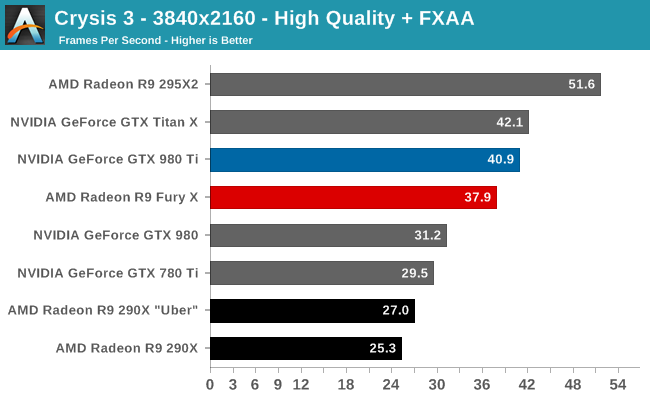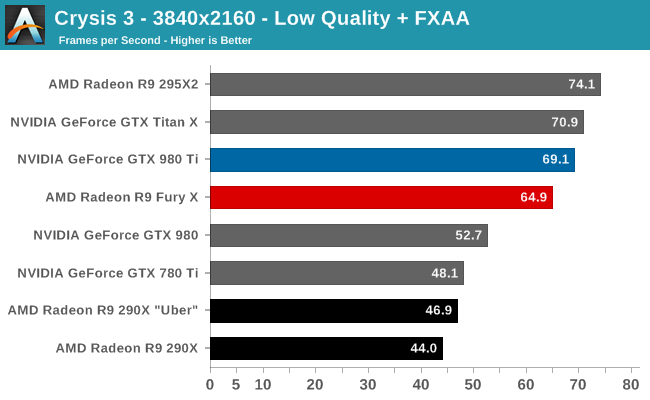The AMD Radeon R9 Fury X Review: Aiming For the Top
by Ryan Smith on July 2, 2015 11:15 AM ESTCrysis 3
Still one of our most punishing benchmarks, Crysis 3 needs no introduction. With Crysis 3, Crytek has gone back to trying to kill computers and still holds the “most punishing shooter” title in our benchmark suite. Only in a handful of setups can we even run Crysis 3 at its highest (Very High) settings, and that’s still without AA. Crysis 1 was an excellent template for the kind of performance required to drive games for the next few years, and Crysis 3 looks to be much the same for 2015.



A pure and strenuous DirectX 11 test, Crysis 3 in this case is a pretty decent bellwether for the overall state of the R9 Fury X. Once again the card trails the GTX 980 Ti, but not by quite as much as we saw in Battlefield 4. In this case the gap is 6-7% at 4K, and 12% at 1440p, not too far off of 4% and 10% respectively. This test hits the shaders pretty hard, so of our tried and true benchmarks I was expecting this to be one of the better games for AMD, so the results in a sense do end up as surprising.
In any case, on an absolute basis this is also a good example of the 4K quality tradeoff. R9 Fury X is fast enough to deliver 1440p at high quality settings over 60fps, or 4K with reduced quality settings over 60fps. Otherwise if you want 4K with high quality settings, the performance hit means a framerate average in just the 30s.
Otherwise the gains over the R9 290XU are quite good. The R9 Fury X picks up 38-40% at 4K, and 36% at 1440p. This trends relatively close to our 40% expectations for the card, reinforcing just how big of a leap the card is for AMD.










458 Comments
View All Comments
mikato - Tuesday, July 7, 2015 - link
Wow very interesting, thanks bugsy. I hope those guys at the various forums can work out the details and maybe a reputable tech reviewer will take a look.OrphanageExplosion - Saturday, July 4, 2015 - link
I'm still a bit perplexed about how AMD gets an absolute roasting for CrossFire frame-pacing - which only impacted a tiny amount of users - while the sub-optimal DirectX 11 driver (which will affect everyone to varying extents in CPU-bound scenarios) doesn't get anything like the same level of attention.I mean, AMD commands a niche when it comes to the value end of the market, but if you're combining a budget CPU with one of their value GPUs, chances are that in many games you're not going to see the same kind of performance you see from benchmarks carried out on mammoth i7 systems.
And here, we've reached a situation where not even the i7 benchmarking scenario can hide the impact of the driver on a $650 part, hence the poor 1440p performance (which is even worse at 1080p). Why invest all that R&D, time, effort and money into this mammoth piece of hardware and not improve the driver so we can actually see what it's capable of? Is AMD just sitting it out until DX12?
harrydr - Saturday, July 4, 2015 - link
With the black screen problem of r9 graphic cards not easy to support amd.Oxford Guy - Saturday, July 4, 2015 - link
Because lying to customers about VRAM performance, ROP count, and cache size is a far better way to conduct business.Oh, and the 970's specs are still false on Nvidia's website (claims 224 GB/s but that is impossible because of the 28 GB/s partition and the XOR contention — the more the slow partition is used the closer the other partition can get to the theoretical speed of 224 but the more it's used the more the faster partition is slowed by the 28 GB/s sloth — so a catch-22).
It's pretty amazing that Anandtech came out with a "Correcting the Specs" article but Nvidia is still claiming false numbers on their website.
Peichen - Monday, July 6, 2015 - link
And yet 970 is still faster. Nvidia is more efficient with resources than they let people on.Oxford Guy - Thursday, July 9, 2015 - link
The XOR contention and 28 GB/s sure is efficiency. If only the 8800 GT could have had VRAM that slow back in 2007.Gunbuster - Saturday, July 4, 2015 - link
Came for the chizow, was not disappointed.chizow - Monday, July 6, 2015 - link
:)madwolfa - Saturday, July 4, 2015 - link
"Throw a couple of these into a Micro-ATX SFF PC, and it will be the PSU, not the video cards, that become your biggest concern".I think the biggest concern here would be to fit a couple of 120mm radiators.
TheinsanegamerN - Saturday, July 4, 2015 - link
My current Micro-ATX case has room for dual 120mm rads and a 240mm rad. plenty of room there